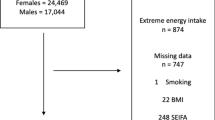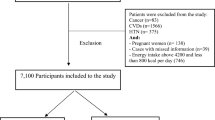Abstract
Background
In recent years, an increasing number of epidemiological studies have suggested a role of polyphenols in the prevention of chronic diseases. Prospective cohort studies have typically measured polyphenol concentrations in a single blood sample and the reproducibility of plasma polyphenol measurements is largely unknown.
Objective
We evaluated the reproducibility of 35 plasma polyphenols collected at an interval of 1-year. We also examined correlations of these polyphenols with food group intakes calculated from weighed food records (WFR) and food frequency questionnaire (FFQ).
Methods
The study included 227 middle-aged participants from the JPHC-NEXT Protocol Area in Japan. We measured 35 polyphenols in plasma collected at two points 1-year apart. Food group intakes were calculated from 12-day WFR and FFQ. For the reproducibility analysis, the intraclass correlation coefficient (ICC) of 35 polyphenol concentrations were examined between the two points. Pearson’s partial correlations was used to assess the correlation between polyphenols and food groups.
Results
Moderate- to high ICCs were observed for tea-originated polyphenols such as gallic acid, quercetin, epigallocatechin, and kaempferol - and coffee-derived polyphenols, such as caffeic acid, and ferulic acid. For the dietary analyses, moderate correlations were observed for non-alcoholic beverages intake and epigallocatechin, epicatechin, catechin, and gallic acid. For green tea, higher correlations were observed with these polyphenols.
Conclusion
Plasma concentrations of tea and coffee-related polyphenols, except for catechin, had good reproducibility over a 1-year period. The correlations between intake of non-alcoholic beverages, particularly green tea, and tea polyphenols, indicated moderate- to high correlations.
This is a preview of subscription content, access via your institution
Access options
Subscribe to this journal
Receive 12 print issues and online access
$259.00 per year
only $21.58 per issue
Buy this article
- Purchase on Springer Link
- Instant access to full article PDF
Prices may be subject to local taxes which are calculated during checkout


Similar content being viewed by others
Data availability
For information on how to submit an application to gain access to Japan Public Health Center-based data/or biospecimens, please follow the instructions at https://epi.ncc.go.jp/en/jphc/805/8155.html.
References
Manach C, Scalbert A, Morand C, Remesy C, Jimenez L. Polyphenols: food sources and bioavailability. Am J Clin Nutr. 2004;79:727–47.
Gardeazabal I, Romanos-Nanclares A, Martinez-Gonzalez MA, Sanchez-Bayona R, Vitelli-Storelli F, Gaforio JJ, et al. Total polyphenol intake and breast cancer risk in the SUN cohort. Br J Nutr. 2019;122:542–51.
Wang ZJ, Ohnaka K, Morita M, Toyomura K, Kono S, Ueki T, et al. Dietary polyphenols and colorectal cancer risk: the Fukuoka colorectal cancer study. World J Gastroenterol. 2013;19:2683–90.
Adriouch S, Lampure A, Nechba A, Baudry J, Assmann K, Kesse-Guyot E, et al. Prospective association between total and specific dietary polyphenol intakes and cardiovascular disease risk in the Nutrinet-Sante French Cohort. Nutrients. 2018;10:1587.
Tresserra-Rimbau A, Rimm EB, Medina-Remon A, Martinez-Gonzalez MA, de la Torre R, Corella D, et al. Inverse association between habitual polyphenol intake and incidence of cardiovascular events in the PREDIMED study. Nutr Metab Cardiovasc Dis. 2014;24:639–47.
Lefevre-Arbogast S, Gaudout D, Bensalem J, Letenneur L, Dartigues JF, Hejblum BP, et al. Pattern of polyphenol intake and the long-term risk of dementia in older persons. Neurology. 2018;90:e1979–e88.
Barnes S. Soy isoflavones–phytoestrogens and what else? J Nutr. 2004;134:1225s–8s.
Ozdal T, Sela DA, Xiao J, Boyacioglu D, Chen F, Capanoglu E. The reciprocal interactions between polyphenols and gut microbiota and effects on bioaccessibility. Nutrients. 2016;8:78.
Williamson G, Clifford MN. Colonic metabolites of berry polyphenols: the missing link to biological activity? Br J Nutr. 2010;104:S48–66.
Zamora-Ros R, Rabassa M, Cherubini A, Urpi-Sarda M, Llorach R, Bandinelli S, et al. Comparison of 24-h volume and creatinine-corrected total urinary polyphenol as a biomarker of total dietary polyphenols in the Invecchiare InCHIANTI study. Anal Chim Acta. 2011;704:110–5.
Xu Y, Le Sayec M, Roberts C, Hein S, Rodriguez-Mateos A, Gibson R. Dietary assessment methods to estimate (Poly)phenol intake in epidemiological studies: a systematic review. Adv Nutr. 2021;12:1781–801.
Bhakta D, dos Santos Silva I, Higgins C, Sevak L, Kassam-Khamis T, Mangtani P, et al. A semiquantitative food frequency questionnaire is a valid indicator of the usual intake of phytoestrogens by South Asian women in the UK relative to multiple 24-h dietary recalls and multiple plasma samples. J Nutr. 2005;135:116–23.
Verkasalo PK, Appleby PN, Allen NE, Davey G, Adlercreutz H, Key TJ. Soya intake and plasma concentrations of daidzein and genistein: validity of dietary assessment among eighty British women (Oxford arm of the European Prospective Investigation into Cancer and Nutrition). Br J Nutr. 2001;86:415–21.
Cao J, Zhang Y, Chen W, Zhao X. The relationship between fasting plasma concentrations of selected flavonoids and their ordinary dietary intake. Br J Nutr. 2010;103:249–55.
Radtke J, Linseisen J, Wolfram G. Fasting plasma concentrations of selected flavonoids as markers of their ordinary dietary intake. Eur J Nutr. 2002;41:203–9.
Ruidavets J, Teissedre P, Ferrieres J, Carando S, Bougard G, Cabanis J. Catechin in the Mediterranean diet: vegetable, fruit or wine? Atherosclerosis. 2000;153:107–17.
Arai Y, Uehara M, Sato Y, Kimira M, Eboshida A, Adlercreutz H, et al. Comparison of isoflavones among dietary intake, plasma concentration and urinary excretion for accurate estimation of phytoestrogen intake. J Epidemiol. 2000;10:127–35.
Frankenfeld CL, Patterson RE, Horner NK, Neuhouser ML, Skor HE, Kalhorn TF, et al. Validation of a soy food-frequency questionnaire and evaluation of correlates of plasma isoflavone concentrations in postmenopausal women. Am J Clin Nutr. 2003;77:674–80.
Wu AH, Yu MC, Tseng CC, Twaddle NC, Doerge DR. Plasma isoflavone levels versus self-reported soy isoflavone levels in Asian-American women in Los Angeles County. Carcinogenesis. 2004;25:77–81.
Frankenfeld CL, Patterson RE, Kalhorn TF, Skor HE, Howald WN, Lampe JW. Validation of a soy food frequency questionnaire with plasma concentrations of isoflavones in US adults. J Am Diet Assoc. 2002;102:1407–13.
Yokoyama Y, Takachi R, Ishihara J, Ishii Y, Sasazuki S, Sawada N, et al. Validity of short and long self-administered food frequency questionnaires in ranking dietary intake in middle-aged and elderly Japanese in the Japan Public Health Center-Based Prospective Study for the Next Generation (JPHC-NEXT) protocol area. J Epidemiol. 2016;26:420–32.
Achaintre D, Gicquiau A, Li L, Rinaldi S, Scalbert A. Quantification of 38 dietary polyphenols in plasma by differential isotope labelling and liquid chromatography electrospray ionization tandem mass spectrometry. J Chromatogr A. 2018;1558:50–8.
Mori N, Murphy N, Sawada N, Achaintre D, Yamaji T, Scalbert A, et al. Prediagnostic plasma polyphenol concentrations and colon cancer risk: the JPHC nested case-control study. Clin Nutr. 2022;41:1950–60.
Maruyama K, Ikeda A, Ishihara J, Takachi R, Sawada N, Shimazu T, et al. Food frequency questionnaire reproducibility for middle-aged and elderly Japanese. Asia Pac J Clin Nutr. 2019;28:362–70.
Dempster AP. Maximum Likelihood from Incomplete Data via the EM Algorithm on JSTOR. 1977;39:–38.
Willett W, Stampfer MJ. Total energy intake: implications for epidemiologic analyses. Am J Epidemiol. 1986;124:17–27.
Olthof MR, Hollman PC, Buijsman MN, van Amelsvoort JM, Katan MB. Chlorogenic acid, quercetin-3-rutinoside and black tea phenols are extensively metabolized in humans. J Nutr. 2003;133:1806–14.
Taguchi C, Kishimoto Y, Takeuchi I, Tanaka M, Iwashima T, Fukushima Y, et al. Estimated dietary polyphenol intake and its seasonal variations among Japanese university students. J Nutr Sci Vitaminol. 2019;65:192–5.
Zamora-Ros R, Lujan-Barroso L, Achaintre D, Franceschi S, Kyrø C, Overvad K, et al. Blood polyphenol concentrations and differentiated thyroid carcinoma in women from the European Prospective Investigation into Cancer and Nutrition (EPIC) study. Am J Clin Nutr. 2020;113:162–71.
Phenol-Explorer: Database on Polyphenol content in foods [Internet]. INRA, AFSSA, University of Alberta, the University of Barcelona, IARC and In Siliflo. 2015. Available from: http://phenol-explorer.eu/.
Watanabe T, Yamamoto A, Nagai S, Terabe S. Simultaneous analysis of tyrosol, tryptophol and ferulic acid in commercial sake samples by micellar electrokinetic chromatography. J Chromatogr A. 1998;825:102–6.
Iwasaki M, Inoue M, Otani T, Sasazuki S, Kurahashi N, Miura T, et al. Plasma isoflavone level and subsequent risk of breast cancer among Japanese women: a nested case-control study from the Japan Public Health Center-based prospective study group. J Clin Oncol. 2008;26:1677–83.
Sasazuki S, Inoue M, Miura T, Iwasaki M, Tsugane S. Plasma tea polyphenols and gastric cancer risk: a case-control study nested in a large population-based prospective study in Japan. Cancer Epidemiol Biomark Prev. 2008;17:343–51.
Acknowledgements
JPHC members (as of November 2021) are listed at the following site: https://epi.ncc.go.jp/en/jphc/781/8510.html. The study was supported by World Cancer Research Fund (WCRF) International Regular Grant Programme 2017/18 (grant number: IIG_2018_1698), National Cancer Research and Development Fund [23-A-31 (Toku) and 26-A-2] (since 2010), and Grant-in-Aid for Cancer Research from the Ministry of Health, Labor and Welfare of Japan (from 1989 to 2010).
Author information
Authors and Affiliations
Contributions
NMurphy, NS, AS, MJG, and ST designed the study. NMori performed the analyses, prepared the tables and drafted the paper. DA, and AS analyzed the samples. NMurphy, NS, DA, and AS supported analyses, discussions and finalizing of the paper. All authors contributed to the interpretation of the results and have read and approved the final manuscript.
Corresponding author
Ethics declarations
Competing interests
The authors declare no competing interests.
Additional information
Publisher’s note Springer Nature remains neutral with regard to jurisdictional claims in published maps and institutional affiliations.
Disclaimer Where authors are identified as personnel of the International Agency for Research on Cancer/World Health Organization, the authors alone are responsible for the views expressed in this article and they do not necessarily represent the decisions, policy or views of the International Agency for Research on Cancer/World Health Organization.
Supplementary information
Rights and permissions
Springer Nature or its licensor (e.g. a society or other partner) holds exclusive rights to this article under a publishing agreement with the author(s) or other rightsholder(s); author self-archiving of the accepted manuscript version of this article is solely governed by the terms of such publishing agreement and applicable law.
About this article
Cite this article
Mori, N., Murphy, N., Sawada, N. et al. Reproducibility and dietary correlates of plasma polyphenols in the JPHC-NEXT Protocol Area study. Eur J Clin Nutr 78, 34–42 (2024). https://doi.org/10.1038/s41430-023-01349-w
Received:
Revised:
Accepted:
Published:
Issue Date:
DOI: https://doi.org/10.1038/s41430-023-01349-w



